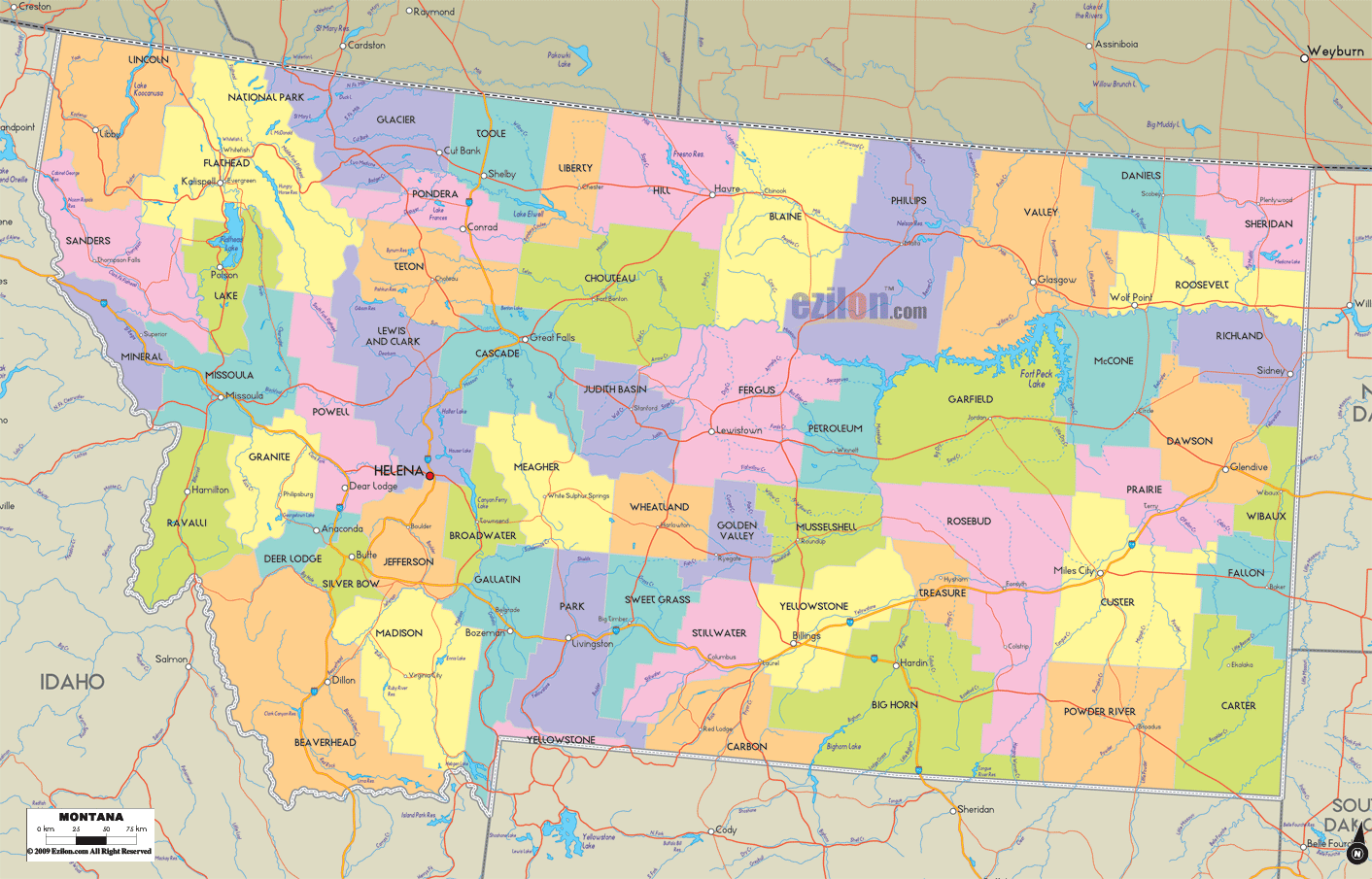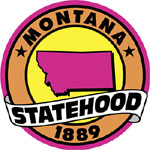

Description: Large map of Montana State, USA showing cities, towns, county formations, roads highway, US highways and State routes.

Montana, often celebrated as the "Big Sky Country" or the "Treasure State," is a vast mosaic of dramatic landscapes, echoing tales of the bygone era and resonating with the vibrant rhythms of modern life. Its vistas range from the endless expanses of the Great Plains in the east to the towering heights of the Rocky Mountains in the west.
The state has witnessed the footprints of Native American tribes, the enthusiasm of gold rush prospectors, the tenacity of pioneers, and the aspirations of countless adventurers. This map intends to showcase Montana's geographical expanse and unravel the intricacies of its cities, towns, counties, byways, and highways, all of which collectively breathe life into this majestic state.
Where The Plains Narrate Ancient Tales: Stretching broadly across Montana's eastern frontier, the plains are vast tapestries of grasslands punctuated by occasional rises and river valleys. Dawson County is a beacon of this region, with Glendive serving as a gateway to the prehistoric wonders of Makoshika State Park, where remnants of dinosaurs silently narrate ancient chronicles.
As you meander towards the southeast, Custer County beckons with the storied cowboy legacy of Miles City. Horse gallops once resonated with enthusiasm in this town, especially during its world-renowned annual Bucking Horse Sale. Drifting north, one encounters the sprawling lands of Valley County with Glasgow at its heart, balancing a rich history with contemporary dynamics.
Makoshika State Park: Located near Glendive, this park is right off I-94. It stands out on the map near the junction of MT-16 and MT-200, adjacent to the Yellowstone River.
Pictograph Cave State Park: Situated just 5 miles south of Billings, you can reach this park via MT-3. The intricate patterns of caves distinguish its location, with the Yellowstone River flowing nearby.
The northern stretch of Montana is where the plains gradually meld into undulating terrains and soft hillocks, a transition zone before the grandeur of the Rockies. Hill County and its centerpiece,
Havre retains a rich tapestry of history, from Native American legacies to the transformative age of railroads. Further east, counties like Sheridan and its key town, Plentywood, offer glimpses of Montana's agricultural backbone and connection to neighboring realms.
Bannack State Park: Positioned southwest of Dillon, this park is accessible via Bannack Road off MT-278. Bannack stands out as a preserved gold rush town near Grasshopper Creek.
First Peoples Buffalo Jump State Park: North of Great Falls is the position of this well-known destination. You can get there by taking Ulm Vaughn Road off of I-15, in the middle of vast open fields.
The hemisphere of the west of Montana is where the land rises, echoing the whispered legends of the Rockies. Herein lies Flathead County - its terrain dotted with pristine lakes like the eponymous Flathead Lake and towns like Whitefish that promise skiing escapades and mountain adventures.
Missoula County, with the vibrant city of Missoula, serves as a cultural crucible - a harmonious blend of academia, arts, and ancient landscapes. Further south, nestled in the Bitterroot Valley, is Ravalli County, with towns like Hamilton guarding Montana's deep-rooted connection to nature and history.
Flathead Lake State Park: Numerous sections within the park border US-93, stretching out across the western and southern sides of Flathead Lake. Look for the city of Polson at the south of the tip as a guiding landmark.
Wild Horse Island State Park: This park, nestled inside Flathead Lake, can be accessed by boat from Dayton, which lies on MT-200 on the lake's western shore.
Placid Lake State Park: Situated northeast of Missoula, this park is a short drive from MT-83, near the junction with Placid Lake Road.
Thompson Chain of Lakes State Park: This elongated park lies just off US-2 between Libby and Kalispell. It stretches along a series of lakes immediately noticeable on the map.
Peaks, Valleys, and Echoes of Yesteryears: The southern contours of Montana are a symphony of soaring peaks, verdant valleys, and ripples of historical significance. Yellowstone County stands tall with Billings, a city that whispers tales of the old and buzzes with the new, serving as a nexus to the natural wonders like the Bighorn Canyon. Gallatin County introduces Bozeman, a harmonious blend of education at Montana State University, vibrant city life, and gateways to outdoor treasures like the Bridger Mountains.
State Park Direction From The Map
Lewis and Clark Caverns State Park: Situated east of Whitehall and directly accessible from I-90, this park's entrances are near the confluence of the Jefferson, Madison, and Gallatin rivers.
Chief Plenty Coups State Park: To the south of Billings lies the park known as Pryor. The simplest way to reach that place is to drive on the MT-416 road.
The Beating Heart Under the Big Sky: Central Montana is where the state's heartbeats resonate loudest. Cascade County's Great Falls, cascading waterfalls on the Missouri River, is an emblem of Montana's hydrological wonders.
Fergus County and its jewel, Lewistown, nestled amidst five valleys, reverberates with echoes of Native American history, pioneer struggles, and modern aspirations. Nearby, counties like Judith Basin and Wheatland amplify Central Montana's diverse mosaic with towns such as Stanford and Harlowton.
State Park Direction From The Map
Sluice Boxes State Park: Located between Great Falls and Billings, you can find this park by tracing US-89 through the Little Belt Mountains. Belt Creek, which meanders through, is a prominent feature.
Ackley Lake State Park: To reach the stunning region of Ackley, one must travel west from Lewistown on MT-200 by car. You can see a lake right next to the Snowy Mountains.
Montana's map, marked by its highways and byways, guides one through unparalleled beauty landscapes punctuated by state parks that serve as gateways to nature's marvels. As you trace the roads of Montana, let's delve into these parks, noting their exact locations, nearby landmarks, and connecting roads.
Interstates and Primary Highways:
I-90: This interstate is Montana's primary east-west corridor, beginning at the Idaho state line near Lookout Pass and skirting through Missoula, Butte, Bozeman, and Billings before progressing into Wyoming. As it winds through the state, travelers get panoramic views of the Bitterroot Mountains and access to historical spots like the Little Bighorn Battlefield.
I-15: Stretching from the Canadian border at Sweetgrass through Great Falls and Helena and finally reaching Idaho near Monida Pass, I-15 is the state's main north-south artery. The scenic byway near Great Falls, with views of the Missouri River, is a particular highlight.
US-2: Known as the Hi-Line, this highway offers a distinctly Montanan experience, running parallel to the Canadian border and connecting communities across the northern plains, such as Havre and Glasgow. The stretch near Glacier National Park offers breathtaking alpine vistas.
US-93: This highway takes travelers from the Canadian border near Eureka, through the Mission Valley, past Flathead Lake, and down to Missoula. Its route further south offers glimpses of the Bitterroot Valley and the Sapphire and Bitterroot Mountain ranges.
Going-to-the-Sun Road: Perhaps the most iconic of all Montana's roads, this scenic route in Glacier National Park is a marvel of engineering and offers views of glaciers, waterfalls, and alpine meadows. It's not just a road but a journey through a natural wonderland.
Beartooth Highway (US-212): Leading to the northeast entrance of Yellowstone National Park, this All-American Road boasts dramatic switchbacks, vast plateaus, and soaring peaks, making it one of the most spectacular drives in the country.
Montana Scenic Loop: This 400-mile loop combines the routes of US-93, MT-200, and MT-83, taking drivers through dense forests, tranquil lakes, and quaint towns. It's a journey that showcases western Montana in all its glory.
Connecting Communities: Roads like MT-1 (Pintler Scenic Route), which winds its way through the Anaconda-Pintler Wilderness, and MT-78, offers beautiful views of the Beartooth Mountains and access to Red Lodge, are crucial in linking more diminutive towns and communities. Though less traveled than the primary highways, these roads hold the heart and soul of Montana, introducing travelers to its lesser-known gems.
Montana, the fourth largest state in terms of area, interestingly is not densely populated. As of recent data, Montana boasts a population of just over a million residents, ranking it 44th in the nation. This low population density plays into the state's nickname, the "Big Sky Country," as vast expanses of land remain untouched, giving way to unobstructed sky views. Most of Montana's populace resides in a handful of urban centers, with Billings, Missoula, and Great Falls being the most populated cities.
Montana's demographic tapestry, though not as diverse as some other states, is rich in its unique history and heritage:
Caucasian: Most of Montana's population identifies as Caucasian, encompassing more than 86% of residents.
Native Americans: Montana has a rich Native American heritage, with around 7% of the population identifying as indigenous. Reservations and tribal territories such as the Crow, Northern Cheyenne, and Blackfeet are a testament to the state's commitment to honoring and preserving its native cultures.
Hispanic and Latino: Constituting just over 4% of the population, the Hispanic and Latino communities have been steadily growing, contributing vibrantly to Montana's cultural milieu.
Other Asian, African American, and Pacific Islander communities, among others, collectively make up the remainder of the population. While these communities are smaller in number, their influence is palpable in various spheres, from cuisine to arts.
In a state as expansive as Montana, air travel is a critical connector, ensuring accessibility to even its remotest corners:
Billings Logan International Airport (BIL): Situated in the largest city in Montana, Billings, this airport is often the gateway for those wanting to explore the southern and eastern parts of the state.
Missoula International Airport (MSO): Serving the western part of Montana, this hub ensures connectivity for places like Missoula and its adjoining areas.
Bozeman Yellowstone International Airport (BZN): As the name suggests, this airport is pivotal for tourists heading to the iconic Yellowstone National Park. Bozeman's airport has seen a surge in traffic due to the region's rising popularity of outdoor pursuits.
Great Falls International Airport (GTF): Ensuring northern Montana stays connected, this airport is crucial for residents and tourists, catering to the region around Great Falls.
Helena Regional Airport (HLN): Though more minor in scale, the capital city's airport plays a significant role in connecting Montana's political and administrative heart.
Kalispell's Glacier Park International Airport (FCA): Positioned close to the Glacier National Park, it's the natural choice for travelers eager to explore the pristine beauty of this UNESCO World Heritage site.
Conclusion: To understand Montana's soul, one must traverse its breadth, soak in its landscapes, engage with its towns and cities, and listen to the tales whispered by its mountains and plains. This map is not just a geographical guide but an intricate narrative, inviting explorers to discover Montana's secrets, one county at a time. Embrace Montana's embrace and let its spirit guide you across its vast and varied tapestry.

Physical Map of Montana
Physical map and map image of Montana.

Regional Directory of Canada
Information and guide about Canada and website listing.

Regional Directory of United States of America
Information and guide about United States of America and websites with American topics.

Regional Directory of Europe
Information and guide about Europe and websites with European topics.

Regional Directory of Australia
Information and guide about Australia and websites with Australian topics.